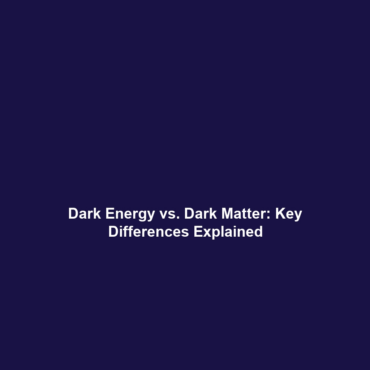How Dark Energy Differs from Dark Matter
Introduction
Understanding how dark energy differs from dark matter is crucial in the field of cosmology. While both dark matter and dark energy make up approximately 95% of the universe, they serve vastly different roles in the cosmos. Dark matter, which interacts through gravity, helps hold galaxies together, whereas dark energy is responsible for the accelerated expansion of the universe. This article delves into the significant differences between dark energy and dark matter, highlighting their importance within the broader context of dark matter and dark energy research.
Key Concepts
Defining Dark Matter
Dark matter is a form of matter that does not emit, absorb, or reflect light, making it invisible and detectable only through its gravitational effects. Comprising about 27% of the universe, it plays a vital role in the formation and stability of galaxies.
Defining Dark Energy
On the other hand, dark energy accounts for roughly 68% of the universe and is a mysterious energy that permeates all of space. It is theorized to drive the accelerated expansion of the universe observed in astronomical data. Understanding dark energy helps scientists uncover the fate of the universe.
Comparative Analysis
Here are some key differences between dark energy and dark matter:
- Nature: Dark matter is gravitationally attractive, while dark energy exhibits repulsive properties that drive cosmic expansion.
- Detection: Dark matter can be inferred from its gravitational effects; dark energy is derived from the observation of cosmic acceleration.
- Impact on Structure: Dark matter helps form and stabilize structures in the universe, while dark energy contributes to their expansion.
Applications and Real-World Uses
Although dark energy and dark matter are primarily theoretical constructs with limited direct applications, their implications resonate within various fields:
- Cosmology: Researchers use findings about dark energy and dark matter to refine models of the universe’s evolution.
- Astronomy: Observations of distant supernovae leverage dark energy principles to study cosmic expansion, influencing theories about the fate of the universe.
Current Challenges
Studying how dark energy differs from dark matter presents several challenges:
- Uncertainty in the nature and properties of dark energy, making it difficult to form definitive testable theories.
- Lack of direct observational evidence for dark matter, creating gaps in the understanding of its characteristics.
- The interplay between dark energy and dark matter complicates models of cosmic evolution and structure formation.
Future Research and Innovations
Numerous innovations are on the horizon regarding dark energy and dark matter research:
- Advanced telescopes are being developed to gather more precise data regarding the universe’s expansion.
- Particle physics experiments aim to detect dark matter particles directly, potentially unveiling new physics beyond the Standard Model.
- Data from gravitational waves may allow scientists to study both dark matter and dark energy in unprecedented detail.
Conclusion
In summary, understanding how dark energy differs from dark matter is pivotal for grasping the broader categories of dark matter and dark energy. These two enigmatic components shape our universe, and ongoing research promises to shed light on their unique properties and roles. For those interested in delving deeper, consider exploring topics like current dark matter research or recent findings on cosmic expansion.

Leave a Reply